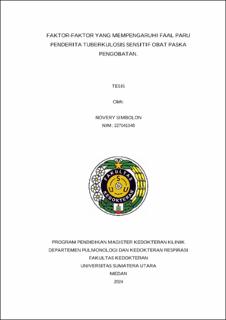| dc.contributor.advisor | Pandia, Pandiaman | |
| dc.contributor.advisor | Pradana, Andika | |
| dc.contributor.author | Simbolon, Novery | |
| dc.date.accessioned | 2025-01-20T03:36:33Z | |
| dc.date.available | 2025-01-20T03:36:33Z | |
| dc.date.issued | 2024 | |
| dc.identifier.uri | https://repositori.usu.ac.id/handle/123456789/100319 | |
| dc.description.abstract | Background: Globally, Indonesia is ranked second in the world for cases of Tuberculosis burden with an incidence of 354 cases per 100,000 population. Tuberculosis treatment has an effectiveness of up to 85% but 50% of cross-tuberculosis patients have pulmonary dysfunction. Lung function disorders can be restrictive, obstruction and mixed. Spirometry is a simple examination tool that can be used to evaluate pulmonary dysfunction. Some studies show restrictive and obstruction disorders but still rarely describe factors such as the extent of lung lesions and the history of recurrent tuberculosis to pulmonary physology.
Objective: This study aims to identify the factors affecting the lung function of patients suffering from tuberculosis sensitive to drug post-treatment in patients treated in Outpatient clinic USU Hospital and Adam Malik Hospital.
Methods: Data that has been collected and then processed and analyzed descriptively to see to see the frequency distribution of the subject of the study based on characteristics. Data in a categorical scale is displayed in percentages while data in a numerical is shown in ratio values and standard deviations. The data will be processed through bivariate analysis using a chi-sqaure test with a degree of fertility p< 0.05 and be continued by multivariate analyses to find out which factor has the greatest role against the independent variable.
Results: Using the enter method, it was found that only one significant independent variable influenced the lung function in patients with drug-sensitive pulmonary tuberculosis in this study is the area of the lesion (p = 0,014) with an Exp (B) value of 4,889 (95% IK = 1,386 – 17,241) which means that subjects with an advanced area of lesion would tend to be at a 4.899 times greater risk of developing an abnormal area of lung function than those with an unadvanced area.
Conclusion: The extent of the lung lesion is the variable that most affects the lung function of patients with post-treatment tuberculosis in this study. | en_US |
| dc.language.iso | id | en_US |
| dc.publisher | Universitas Sumatera Utara | en_US |
| dc.subject | tuberculosis | en_US |
| dc.subject | post-treatment | en_US |
| dc.subject | pulmonary physiology | en_US |
| dc.subject | spirometry | en_US |
| dc.title | Faktor-Faktor yang Mempengaruhi Faal Paru Penderita Tuberkulosis Sensitif Obat Paska Pengobatan | en_US |
| dc.title.alternative | Faktors That Affect Lung Function in Patients with Drug-Sensitive Tuberculosid After Treatment | en_US |
| dc.type | Thesis | en_US |
| dc.identifier.nim | NIM227041048 | |
| dc.identifier.nidn | NIDN0019056110 | |
| dc.identifier.nidn | NIDN0023128907 | |
| dc.identifier.kodeprodi | KODEPRODI11103#Ilmu Kedokteran Klinis | |
| dc.description.pages | 99 Pages | en_US |
| dc.description.type | Tesis Magister | en_US |
| dc.subject.sdgs | SDGs 3. Good Health And Well Being | en_US |


